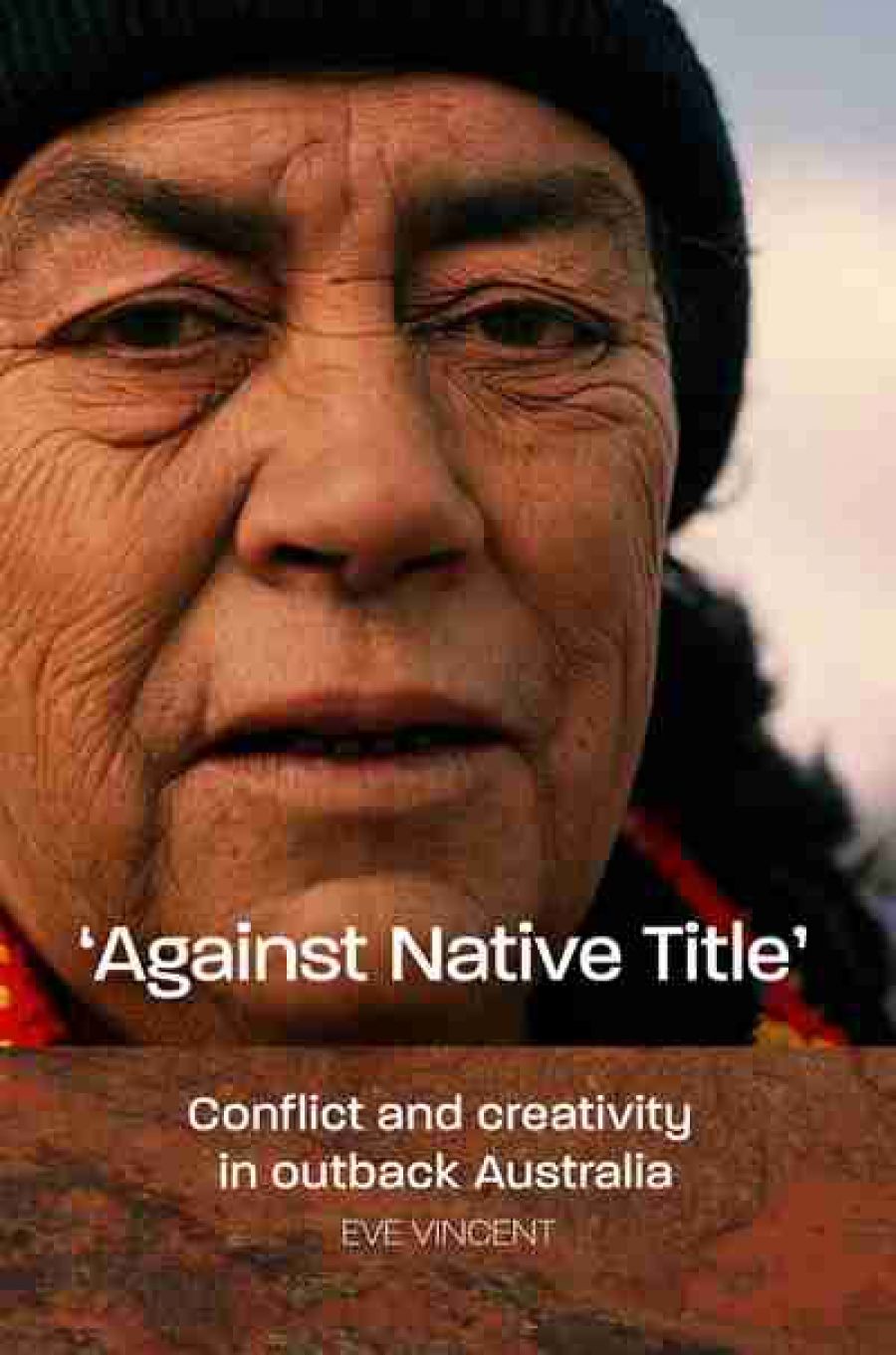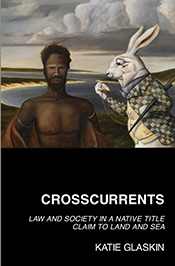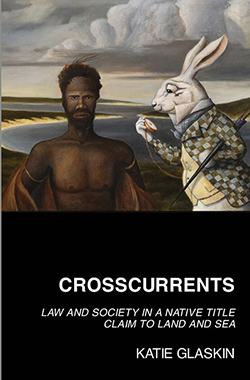
- Free Article: No
- Contents Category: Indigenous Studies
- Custom Article Title: Richard J. Martin reviews '"Against Native Title": Conflict and Creativity in Outback Australia' by Eve Vincent and 'Crosscurrents: Law and society in a native title claim to land and sea' by Katie Glaskin
- Custom Highlight Text:
The year 2017 marked the twenty- fifth anniversary of the High Court’s 1992 decision in Mabo v Queensland (No 2) (Mabo), which recognised the existence of Indigenous people’s traditional ‘native title’ rights over the Murray Islands in the Torres Strait. This finding, and the passage through parliament of the ...
- Book 1 Title: Against Native Title
- Book 1 Subtitle: Conflict and Creativity in Outback Australia
- Book 1 Biblio: Aboriginal Studies Press, $34.95 pb, 252 pp, 9781925302080
- Book 2 Title: Crosscurrents
- Book 2 Subtitle: Law and society in a native title claim to land and sea
- Book 2 Biblio: UWA Publishing, $39.99 pb, 302 pp, 9781742589442
- Book 2 Cover Small (400 x 600):

- Book 2 Cover (800 x 1200):

- Book 2 Cover Path (no longer required): images/ABR_Online_2018/May_2018/Crosscurrents.jpg
Against Native Title presents a bracing critique of native title via an ethnographic biography of Aunty Sue. In the period that Vincent describes (from the late 1990s to the mid-2000s), Aunty Sue and her relations (the ‘Aunty Sue Mob’) were in dispute with other Aboriginal people involved in the Far West Coast native title claim around Ceduna in South Australia. As Vincent describes, this dispute arose as a result of research findings which distinguished Ceduna people with Kokatha ancestry, like Aunty Sue Mob, from those with Wirangu forebears. To Aunty Sue Mob’s dismay, research identified the Ceduna area as having been traditionally occupied by Wirangu people, resulting in those with Kokatha ancestry being seen as members of a historically incoming group. As a result, Aunty Sue Mob came to ‘resent the rise of locally prominent Wirangu figures, perceiving that [Wirangu people’s] recognition and valorisation occurs at [Aunty Sue Mob’s] expense’.
Vincent deals sensitively with the politics of this intra-Indigenous dispute, explaining her reluctance to include material that will ‘expose Aunty Sue Mob to more pain’. The real target of Vincent’s critique is the ‘state effects’ and ‘imaginings’ involved in native title. She argues: ‘It is no exaggeration to say that Aunty Sue Mob have experienced native title as a powerful incitement and unwelcome imposition – as something that has emanated from the state, that has resulted in their own affective dispossession, and out of which they have gained only enemies.’
For Vincent, native title forecloses alternative possibilities for Indigenous empowerment, creating conflict among Indigenous people by encouraging them to re-identify with what Vincent depicts as antiquated ‘tribal’ identities like Wirangu rather than more contemporary identities like ‘Ceduna Nungas’. Vincent’s preference is for novel articulations of indigeneity, which include coalitions of Indigenous people and ‘greenies’ working to ‘reimagine and invert the established social hierarchy’ and ‘forge, shape and inhabit … [an] alternate reality’.
There is an element of utopianism in this critique, which some readers will find attractive, but it risks providing an overly simplistic account of native title – a problem compounded by Vincent’s alignment with a single faction in the complicated social field created by the Far West Coast native title claim. In presenting a critique of ‘the state’, Vincent diverts attention away from the symbolic as well as material stakes of Aunty Sue Mob’s dispute with other Aboriginal people involved in this claim, and the broader Indigenous politics associated with claiming native title. Consequently, Sue Coleman Haseldine’s decision to join the Prescribed Body Corporate set up in the aftermath of the successful Far West Coast claim – which seems to contradict Vincent’s view of the ‘resolutely colonial nature’ of native title – is left unexplained.
The anthropologist Katie Glaskin’s Crosscurrents: Law and society in a native title claim to land and sea presents a more nuanced account of native title’s social effects. In this ethnography, Glaskin describes the Bardi and Jawi peoples’ native title claim Sampi v State of Western Australia over land and waters near Broome in the West Kimberley. Her account of this case shows how complicated and ambiguous native title can be ‘as legislation and as process’.
Sampi began in 1993, when Bardi and Jawi people issued instructions through their lawyers to lodge the claim. This initiated a process that continued through a Federal Court hearing in the early 2000s (determined in 2005), and then an appeal before the Full Federal Court in 2007 (determined in 2010). Drawing on her experiences as an anthropologist commissioned by the claimants to provide expert reports and evidence in this legal process, Glaskin analyses the ‘paradoxical’ ways Bardi and Jawi peoples’ connections to country were affected by their participation in this claim.
As in the Far West Coast claim, the relationship between different Aboriginal peoples involved in Sampi was the focus of much research interest, with respondent parties seeking to limit the recognition of native title offshore by emphasising the differences between Bardi and Jawi peoples. For native title to be recognised by the Courts, traditional Indigenous ‘laws and customs’ must be shown to have continued ‘substantially uninterrupted’ since the time of British colonisation. If Indigenous traditions are shown to have been abandoned and revived or otherwise significantly changed from their pre-colonial content, native title is deemed to have been ‘extinguished’, and claims to hold rights and interests under Australian law are dismissed by the courts. Respondent parties in Sampi sought to achieve this by seeking to show that the Jawi had ceased to exist as a ‘society’, and that the Bardi had only acquired access to mangrove log rafts enabling sea navigation after contact, resulting in the extinguishment of native title offshore.
Glaskin’s book offers a subtle account of the great complexities of Indigenous culture and history, and the tensions, ironies, miscommunications, and contradictions – or ‘crosscurrents’ – that native title creates. In Sampi, these ‘crosscurrents’ were particularly strong, as the case dragged on and new jurisprudence changed the kind of questions being asked of Bardi and Jawi people, such that strategic decisions taken in the early 1990s came to have an impact on conceptualisations of Bardi and Jawi people’s relationships to one another as the case proceeded towards determination some fifteen years later.
In the first Federal Court judgment, Justice French found that Jawi people had been incorporated into Bardi ‘society’, meaning that native title could not be recognised over Jawi country, notwithstanding what the judge saw as the Jawi people’s ‘substantial body of traditional knowledge’. In the end, this decision was overturned on appeal, with the Full Federal Court finding that the Bardi and Jawi peoples constitute a single society, allowing the Jawi country under claim (islands and sea) to be included in the determination of native title. The ‘paradox’ of such recognition is that the Bardi and Jawi peoples came to increasingly present themselves as the ‘Bardi Jawi’ people over the period that Glaskin describes, with Glaskin depicting this conjoined identity as arising from the interaction of Indigenous cultural politics and Australian law.
This is the ‘paradox of recognition’, whereby Indigenous understandings and practices are subtly yet profoundly transformed by native title. Twenty-five years after Mabo and the Act, these two books offer diverse insights into the fission and fusion generated by this curious feature of post-colonial Australia.


Comments powered by CComment